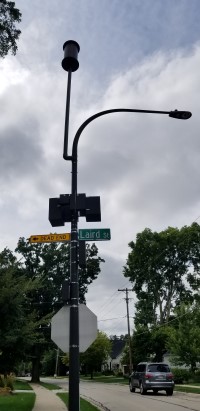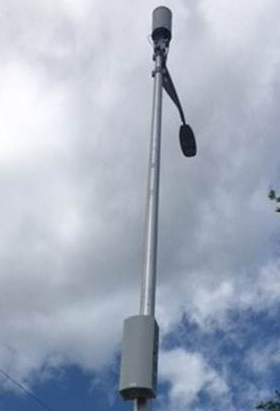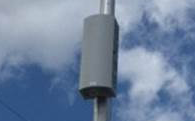5G and Small Cell Wireless Facilities
5G is the next generation of telecommunications technology, which will meet the need for increasingly fast internet and cellular data transmission in today’s society. 5G networks will be much faster than the 4G networks in use now and will be able to handle more connected devices. This will help support new smart devices, facilitate better virtual meeting connections and allow for fresh innovations.
Wireless service providers are looking to expand their capabilities in 5G networking by building small cell wireless facilities in the communities they cover. 5G signals, while higher in frequency than 4G signals, do not travel as far. So instead of traditional, or “macro” cell towers that are usually 200 feet or more in height, wireless service providers are turning to smaller facilities – bundles of antennas, transmitters and other equipment called small cells. Small cells are typically 30 feet tall or less; however, due to their lower height, they must be installed in closer proximity to provide coverage for the areas they serve.
Small Cell Governance
Wireless service providers are beginning to install the small cell infrastructure and equipment necessary to move toward 5G, and these upgrades will lead to construction activity beginning soon on streetlights and utility poles in Naperville. Streetlight and utility poles are of adequate height and separation to accommodate 5G antennas without the need for installing additional poles across the City. Using existing streetlight and utility poles helps to minimize the aesthetic impact of the upgraded 5G service.
A state law adopted in 2018 governs the installation of small cell wireless facilities. This law gives wireless service providers broad permissions to install small cells within the public right-of-way. The law was designed to ensure “providers of wireless access have a fair and predictable process for the deployment” of this new technology. The law was not designed to give municipalities control over the location and number of small cells within their jurisdictions. In fact, it restricts zoning review, caps permit and rental fees and limits the time a municipality can take to evaluate applications. An order from the Federal Communications Commission in 2018 similarly limits municipal control over small cell facilities, with the intent of streamlining the rollout of 5G services nationwide.
View the Illinois Small Wireless Facilities Deployment Act
View the FCC 5G Deployment Order
The City’s Role
According to state law, much of the regulatory authority over small cell wireless facilities is outside of City control. Here is what the City CAN and CANNOT do to oversee this new technology.
The City CAN require wireless service providers to:
- Get a permit to install a small cell wireless facility on a City streetlight or utility pole.
- Provide structural integrity specifications for each proposed site.
- Provide photos and exact locations of streetlight or utility poles where small cell wireless facilities would be installed.
- Limit the height of a small wireless facility to 10 feet above the streetlight pole, utility pole or other structure on which the equipment is mounted.
- Comply with safety standards for construction in the right-of-way as well as standards for wiring, cabling, grounding, streetlight or utility pole extensions and signage.
- Install new streetlight or utility poles, at the provider’s cost, if existing poles are not strong enough to support small cell wireless equipment.
- Ensure small cell wireless facilities do not interfere with public safety communications or other utilities; permits may be terminated by the City if interference occurs.
The City CANNOT:
- Enact a ban on small cell wireless facilities.
- Require zoning review for locations of small cell wireless facilities if they are on any property zoned for commercial or industrial use, or if they are in the right-of-way – even in residential areas.
- Deny an application to prevent a small cell wireless facility at a specific site, unless it fails to comply with standards for location, size, surface area, height or construction safety, or causes interference with public safety communications.
- Deny a proposed location for a small cell wireless facility without providing an alternate location within 100 feet.
- Grant exclusive rights to any one wireless service provider to install small cell wireless facilities in City right-of-way.
- Regulate the level of radio frequency emissions. This is the responsibility of the Federal Communications Commission.
Plan Review and Inspections

The City of Naperville has designed a thorough plan-review process, which ensures installation of every small cell is conducted in a way that promotes safety, responsibility, cleanliness, restoration of property and the least impactful construction process possible.
Even before an application is received, City staff members evaluate proposed small cell locations and consult with wireless service providers through an award-winning pre-application process. This process has been recognized with the Exemplary Systems in Government Award for Enterprise Systems from URISA, the Urban and Regional Information Systems Association. This early review helps providers choose optimal sites where small cells will not interfere with utilities or public safety communications.
Once an application is submitted, it is reviewed by a team including staff members from the Electric and Water utilities as well as Legal, Public Safety, Planning and Engineering and other departments. These reviewers ensure that each proposed facility meets standards for electrical safety, structural integrity and aesthetics and that it complies with state and federal law. Once an application is approved, the wireless service provider is given a permit to begin work.
Once a permit is issued for a specific location, utility crews mark the placement of their lines as a safeguard to ensure digging for a new small cell site will not disrupt water, electric or other services. Several inspections take place during and after construction to ensure that the foundation is structurally sound, electrical connections meet code and the parkway is restored without divots or damaged grass.
This entire process benefits City residents and constituents by providing small cell installations that are safe and complaint from conception to completion.
Installation Process
Installation of a new small cell wireless facility typically takes place in separate phases during the course of several weeks. Here is a look at the process:
- Fiber: Before installation can begin, underground fiber-optic cable must already be in place. Cellular providers have been working for the past few years to install this fiber infrastructure throughout the City.
- Foundation: Digging out and pouring a foundation for a new streetlight or utility pole is the first construction step residents and property owners will see after a small cell wireless facility has received a permit.
- Electrification: Once a foundation is set, City Electric Utility crews will connect service to the site to power the equipment within the small cell.
- Pole Replacement: Wireless service providers will erect a new streetlight or utility pole at each small cell location. These new poles are stronger and structurally sufficient to hold the required communications equipment. The old pole will be removed.
- Restoration: Wireless service providers, as a condition of their permit, are required to restore the area around the new streetlight or utility pole to meet the standards of a City inspection.
Photos

Small cell equipment can be added, with sleek concealment, in a box to a new or existing streetlight or utility pole, as it is here, in one of the first 5G installations in Naperville.

This image, also from one of the first 5G installations in Naperville, gives a close-up look of how well-concealed small cell equipment can be.
Small Cell Wireless Facility Locator Map
This interactive map shows streetlight and utility poles within the City of Naperville. Color-coding identifies poles where wireless service providers have applied for small cell permits, as well as poles for which a permit has been issued and poles where small cell construction is complete. Use this map to check whether there are any small cell wireless facilities planned or underway near you and to find out the pole number, permit number and contact information for the wireless service provider responsible for the equipment.
Frequently Asked Questions
What is a small cell wireless facility? What does it do?
A small cell wireless facility is a piece of broadband infrastructure containing cellular antenna components. This equipment uses high-frequency electromagnetic waves to provide 5G wireless communication coverage to a small area. This equipment is typically smaller and more compact than a traditional, or “macro” cell tower, and it is often installed on existing or new utility poles.

